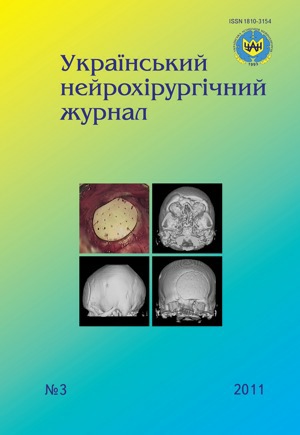Pathomorphological changes of rat’s tail intervertebral disks and vertebrae bodies at asymmetric static compression-distension in the experiment
DOI:
https://doi.org/10.25305/unj.57798Keywords:
osteochondrosis, intervertebral discs’ degeneration, nucleus pulposus, fibrous ring, chondrocytes, necrosis, notochordal cellsAbstract
Constant asymmetric static compression-distention (ASCD) of tail segments of the spine was performed in rats by tail stump sewing to its base in the experiment. In period of 1–3 months using histological method it was fixed that ASCD led to pathological changes in intervertebral disks and vertebrae bodies, mainly caused by ischemia and dystrophy. The most constant histologicaly expressed component of intervertebral disks’ damage — is macrofocal cell necrosis in collagen plate of the fibrous ring on the side of compression, accompanied by crumple, significant fiber prevalence and cracking of the plates with perifocal zone of chondrocyte proliferation, but these changed didn’t result in substitution of focal damage in terms of observation. Zones of notochondral cells necrosis were inconstantly noted in the structures of nucleus pulposus and closing plates of vertebrae bodies and small osteomedullary zones of necrosis — in epiphysis and epiphyseal cartilages of the vertebrae bodies. Changes of osseous epiphyses and epiphyseal cartilages height, adjoining to disk in ASCD zones of fibrous ring and also vertebrae bodies marginal ossificates were inconstant and had no correct character.
References
Волков А.В. Морфологические изменения межпозвонкового диска крысы в условиях асимметричной статичной компрессии: дис. … канд. мед. наук: спец. 03.00.25. — гистология, цитология, клеточная биология / А.В.Волков. — М., 2008. — 133 с.
Quint U. Grading of degenerative disk disease and functional impairment: imaging versus pathoanatomical findings / U. Quint, H.-J. Wilke // Eur. Spine J. — 2008. — V.17. — P.1705–1713.
Pazzaglia U.E. The effects of mechanical forces on bones and joints. Experimental study on the rat tail / U.E. Pazzaglia, L. Andrini, A.Di Nucci // J. Bone Joint Surg. — 1997. — V.79-B, N6. — P.1024–1030.
New in vivo animal model to create intervertebral disc degeneration and to investigate the effects of therapeutic strategies to stimulate disc regeneration / M.W. Kroeber, F. Unglaub, H. Wang [et al.] // Spine. — 2002. — V.27, N23. — P.2684–2690.
Григоровский В.В. Изменения в межпозвоночных дисках и телах позвонков при нарушении сегментарного кровоснабжения и дополнительной острой травме в эксперименте / В.В. Григоровский, В.А. Улещенко // Ортопедия, травматология. — 1985. — №3. — С.21–24.
A new porcine in vivo animal model of disc degeneration: response of annulus fibrosus cells, chondrocyte-like nucleus pulposus cells, and notochordal nucleus pulposus cells to partial nucleotomy / G.W. Omlor, A.G. Nerlich, H.J. Wilke [et al.] // Spine. — 2009. — V.34, N25. — P. 2730–2739.
Notochordal cells produce and assemble extracellular matrix in a direct manner, wich may be responsible for the maintenance of healthy nucleus pulposus / R. Cappello, J.L. Bird, D. Pfeiffer [et al.] // Spine. — 2006. — V.31, N8. — P.873–882.
A slowly progressive and reproducible animal model of intervertebral disc degeneration characterized by MRI, X-ray, and histology / S. Sobajima, J.F. Kompel, J.S. Kim [et al.] // Spine. — 2005. — V.30, N1. — P.15–24.
Intervertebral disc repair using adipose tissue-derived stem and regenerative cells: experiments in a canine model / T. Ganey, W.C. Hutton, T. Moseley [et al.] // Spine.— 2009. — V.34, N21. — P.2297–2304.
Olfactory stem cells can be induced to express chondrogenic phenotype in a rat intervertebral disc injury model / W. Murrell, E. Sanford, L. Anderberg [et al.] // Spine J. — 2009. — V.9, N7. — P.585–594.
In vivo intervertebral disc regeneration using stem cell-derived chondroprogenitors / H. Sheikh, K. Zakharian, R.P. De La Torre [et al.] // J. Neurosurg. Spine. — 2009. — V.10, N3. — P.265–272.
Effects of immobilization on intervertebral disc cell gene expression in vivo / J.J. MacLean, C.R. Lee, S. Grad [et al.] // Spine. — 2003. — V.28, N10. — P.973–981.
Erwin W.M. Notochord cells regulate intervertebral disc chondrocyte proteoglycan production and cell proliferation / W.M. Erwin, R.D. Inman // Spine. — 2006. — V.31, N10. — P.1094–1099.
Юхта М.С. К вопросу о применении клеточной терапии при дегенеративно-дистрофических повреждениях межпозвонковых дисков / М.С. Юхта, В.И. Грищенко // Вісн. ортопедії, травматології та протезування. — 2010. — №4. — С.70–75.
Effects of implantation of bone marrow mesenchymal stem cells, disc distraction and combined the rapy on reversing degeneration of the intervertebral disc / H.T. Hee, H.D. Ismail, C.T. Lim [et al.] // J. Bone Joint Surg. — 2010. — V.92-B, N5. — P.726–736.
Cell transplantation in lumbar spine disc degeneration discus / C. Hohaus, T.M. Ganey, Y. Mincus [et al.] // Eur. Spine J. — 2008. — Suppl.4. — P.492–503.
Downloads
Published
How to Cite
Issue
Section
License
Copyright (c) 2011 Valeriy Grigorovsky, Mykhaylo Khyzhnyak, Irina Vasileva, Irina Shuba, Yuriy Gafiychuk

This work is licensed under a Creative Commons Attribution 4.0 International License.
Ukrainian Neurosurgical Journal abides by the CREATIVE COMMONS copyright rights and permissions for open access journals.
Authors, who are published in this Journal, agree to the following conditions:
1. The authors reserve the right to authorship of the work and pass the first publication right of this work to the Journal under the terms of Creative Commons Attribution License, which allows others to freely distribute the published research with the obligatory reference to the authors of the original work and the first publication of the work in this Journal.
2. The authors have the right to conclude separate supplement agreements that relate to non-exclusive work distribution in the form of which it has been published by the Journal (for example, to upload the work to the online storage of the Journal or publish it as part of a monograph), provided that the reference to the first publication of the work in this Journal is included.









